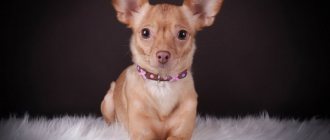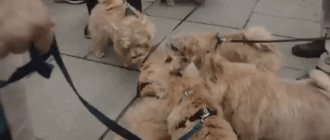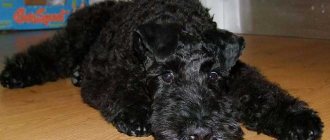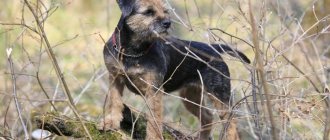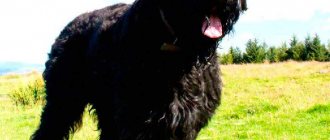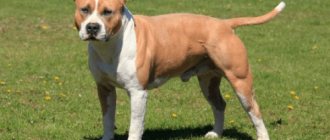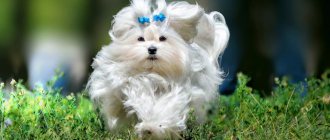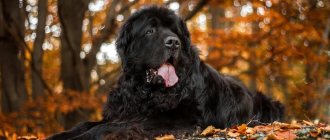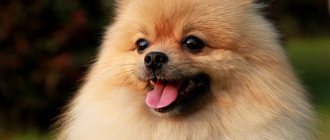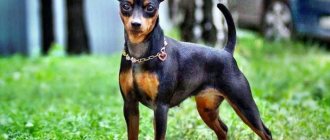History of the Bedlington Terrier breed
The first Bedlingtons appeared in the northern counties of England in the 18th century. At that time, the breed was known as the Rothbury Terrier, and its representatives were bred by gypsies and traveling circus troupes. The ancestors of today's Bedlingtons did not look very presentable, but they demonstrated amazing prey, providing gypsy families with rabbit stew all year round. Animals were also brought to work by English slaughterers. Dogs were lowered into the mine to deal with the hordes of rats and mice that lived inside and destroyed the meager meals of the workers.
In the 19th century, the British Esquires began to acquire Rothbury Terriers. Among the first to do this were William Allan and Edward Donkin, who lived in the vicinity of Northumberland and kept on their property many breeding individuals that were crossed with other breeds. As for the modern name, it came to terriers in 1825, when Northumberland dogs took part in a demonstration hunt in the vicinity of the city of Bedlington.
Since 1859, the breed has won dog shows, and the offspring of its representatives have been registered in the stud books of Northumberland County. Already in 1893, the Bedlingtons had their own national club, and four years later a separate standard was written for them. Further - more: the descendants of Rothbury Terriers went to conquer North America, where they were warmly received and even registered with the AKC. By the way, during the era of the “roaring 20s” in the USA, the breed lines of Colonel Guggenheim and William Rockefeller, who raised the first American champion Bedlingtons, became especially famous.
Brief history of origin
This breed was bred in England in 1970. It got its name from the city of Bedlington. And bull terriers, whippets and dandy-dinmont terriers took part in its formation.
Interesting. For a long period, dogs of this breed were called “the favorite companions of northern miners.” Later they began to be called “gypsy dogs”, and then – Rothbury terriers.
Bedlingtons were originally used to hunt rats, otters, foxes and other small game. But now dogs are bought mainly as companions.
Bedlington Terrier breed standard
The modern Bedlington Terrier is a glamorous fashion model with indescribable plasticity of movements and noble grace of the silhouette. Having given up his profession in the last century, this charmer quickly transformed into a regular at exhibitions and an elegant companion with whom he would not be ashamed to appear at a social gathering. Wool plays an important role in the aristocratic image of Bedlingtons. Fluffy, forming stylish rings on its face, it resembles a bizarre mix of lamb and poodle “fur coats”.
Sexual dimorphism in the breed is pronounced. Bitches are shorter and generally more graceful than males. Males have a more textured appearance and toned figures, but at the same time retain their natural grace and slightly dry appearance. The height range of dogs at the withers is from 37 to 45 cm, weight varies from 8 to 10 kg.
A haircut with smooth transitions gives Bedlington Terriers a slight cosmic chic. Thanks to this technique, the dog’s head takes on a distinctly ovoid shape, reminiscent of the skull of an alien creature.
Head
The Bedlington Terrier has a narrow, rounded skull of good depth and without a pronounced stop. The top of the head is covered by a fluffy white cap. The line going to the nose from the back of the head is smooth, without bulges or depressions.
Nose
The lobe is black or brown, depending on the color of the coat. The nostrils are well defined and large in size.
Lips, jaws, teeth
The dog's lips fit tightly to the long, narrow jaws. The teeth are large and strong, closing into regular “scissors.”
Eyes
The brilliant small eyes of the Bedlington Terrier are set deep. A mandatory nuance is the angular cut of the eyelids, which makes the eyes look triangular. The color of the iris directly depends on the shade of the coat. Blue dogs have dark eyes, tan and blue dogs have brown-amber eyes, and liver and sand dogs have light hazel eyes.
Ears
The Bedlington's ear flap is medium in size, very thin, resembling the outline of a walnut leaf. The ears are set low and droop down along the cheekbones. The skin on the outside is covered with short velvety hair and has neat fringed tassels on the ear tips.
Neck
The low-set neck of the Bedlington Terrier has no chin, is of good length and widens in the shoulder area.
Frame
The dog's body is muscular, flexible, longer than the height of the animal at the withers. A distinctive feature of the silhouette is an arched back with a dome-shaped curve in the lumbar region. The Bedlington Terrier's chest is deep with flat ribs. The lower abdomen and groin line are well toned.
Limbs
The front legs are without curvature, but the distance between them at chest level is greater than at paw level. The shoulders of representatives of the breed are flattened and set obliquely; pasterns slightly sloping. The hind limbs of the Bedlington Terrier are more muscular and longer than the front ones. The hock joints are well defined, without eversion. Long hare feet with plump, tightly compressed toe pads look impressive. In a calm environment, the Bedlington Terrier moves with a springy mincing step, but if necessary, it can speed up and switch to a swaying gallop.
Tail
The Bedlington's tail is of normal length and curved. It is strong at the base, smoothly turning into a thin tip. A prerequisite is that the tail should not be held higher than the back.
Wool
The silky thick coat does not lie tightly to the skin, but does not puff up to the sides either. In addition, the hair can curl into rings, which is especially noticeable in the area of the muzzle and head.
Color
Standard colors: blue, tan, blue, liver and sand (with or without tan).
Disqualifying faults
Serious disadvantages of Bedlington Terriers are:
- cryptorchidism;
- non-standard color and coat structure;
- brown earlobes, lips and eyelids with blue or blue and tan fur;
- undershot or overshot;
- depigmented skin of the eyelids, nose, lips.
Behavioral deviations from the norm are also sufficient grounds for disqualification. If an animal behaves cowardly or aggressively, it will not be allowed into the ring.
Mating
The first mating should not be earlier than the dog turns 24 months old . A pair is selected taking into account exhibition achievements, as well as the potential for improving the breed characteristics of the parents in the offspring. Mating is carried out on the male's square; the future parents can be first introduced on neutral territory. After the first meeting, mating is repeated 2-3 more times , with a break of a day.
Read a detailed article on the topic: “Everything you need to know about breeding dogs: appropriate age, what to do if it doesn’t work out, rules and tips.”
Character of the Bedlington Terrier
Beneath the Bedlington’s angelic appearance lies a classic “terrier” dog, periodically trying on the leader’s crown and terrorizing small fluffies depending on the mood. And yet, decades of exhibition breeding have not been in vain, so the breed, of course, has hunting instincts, but not in such a heightened state as, for example, in Jagdterriers. The Bedlington Terrier can be called a master of disguise. This stylish handsome guy transforms with equal success into both an intelligent, good-natured person and a cunning egoist who fiercely defends his own position.
Bedlingtons do not tend to show aggression towards humans, but sometimes the pet is able to give a test “bite” if the owner has crossed the boundaries of what is permitted and is planning an execution such as a routine vaccination or claw trimming. The Bedlington Terrier integrates into the society of other dogs without any problems, but this does not mean that he is ready to serve in a pack. On the contrary, this comrade will certainly respond to every provocation on the part of his fellow tribesmen, not forgetting to use his signature evasions and sudden bites in the “rear” in the fight.
At home, Bedlington is practically a good boy. He is moderately playful, not annoying and always in a great mood. The breed will also not turn the apartment upside down, although its representatives are distinguished by increased energy. But being jealous of the owner’s cats is a sacred thing for a Bedlington Terrier, so in the presence of a purring dog, it’s better not to be too affectionate. If there are children in the house, the dog is ready to accept this fact as a given, but only on the terms of polite neighborliness. If little naughty creatures regularly pester the animal, causing it discomfort, the Bedlington Terrier may fight back. Keep this in mind and try to limit communication between your pet and children if the latter see the four-legged creature as a living toy.
As for the famous terrier obstinacy, the Bedlingtons were not spared. Well, in order to get to know this character trait of a dog, it’s enough to shout at it well or infringe on its rights and established habits. The dog will respond to such “universal injustice” with moderate disobedience, or even with secretly planned revenge. Otherwise, the Bedlington Terrier is a moderately calm and friendly companion who loves joint outings and road trips. Yes, sometimes he is not averse to loosening the neighbor’s flowerbed and demonstrating the sharpness of his teeth on the furniture upholstery, but all this is more out of boredom and idleness than out of harm.
Character and behavior
Bedlingtons are mischievous, sensitive and very intelligent dogs. They love to spend time with their owners and enjoy playing with children. By nature, these dogs are extroverts who love to be the center of attention.
The character of representatives of this breed is more restrained in comparison with other terriers. But despite their outward calm, if necessary, they become fast, courageous and even aggressive.
Bedlington Terriers are characterized by heightened perception, which allows them to almost accurately determine the character of their host's guests. Therefore, they make good guard dogs, warning of the approach of strangers.
Bedlington Terriers do not get along well with other pets.
Education and training
It is important to answer the question from the very beginning: for what purpose was the dog purchased? If this is a representative of the working lines with whom a full-fledged hunt is planned, then the educational process will have to be combined with elements of training. By the way, once you have awakened the hunting instincts in a Bedlington Terrier, you will not be able to pacify them, so either do not start hunting with the breed at all, or do it on an ongoing basis. As for domestic and show animals, of which the vast majority are in Russia, they can be trained according to the classic scenario: socialization - education - training. Owners of show pets will additionally have to learn the basics of handling (an exhibition demonstration of an animal), or entrust this task to a specialist who will teach the dog the ring stance and correct movements.
Home classes can be combined with trips to training grounds, but such lessons should not be mutually exclusive. Remember, the dog is obliged to follow commands in any situation, and not just when the figure of a professional trainer is looming over it. Walking is also best used to practice basic skills from the OKD course. True, before starting outdoor activities, your pet needs to be given the opportunity to run around and let off steam.
Otherwise, Bedlington Terriers are trained in the same way as the rest of the group, that is, they make it clear that dominance over the owner will not work. The command given by a person must certainly be executed. You need to start obedience lessons at two months of age, when the puppy is ready to learn the demands of “Come to me!” and “Place!” At four months you can introduce more complex commands “Near!” and “Sit!” By the way, about the last command: experts do not recommend introducing it into the skills of show dogs, since in the ring animals are exhibited exclusively in a standing position.
In the first year of life, Bedlington Terriers are the most active and ready to play pranks, so be prepared to hide wires, expensive shoes, and cover upholstered furniture. It is better to replace all these items with toys that the dog will bite, chew and scratch. If your pet makes a mistake, you should not yell at him. Bedlington Terriers agree to recognize their owner as the leader of the pack, but do not tolerate hysterical swearing. In order for the puppy to realize the mistake, a stern tone is enough. And of course, no retroactive punishments - animals are simply not able to understand their expediency.
Psychology
Alert, active and intelligent, the Bedlington, like the Petit Brabançon , is a wonderful companion and watchman.
Main character traits:
- Smart and easy to train. Use praise, games, and food rewards to train. Harsh words and force will not work here. The dog successfully participates in competitions, where it can show its terrier tenacity and desire to find prey underground, as well as show its speed, grace and enthusiasm.
- Exercise is important to keep a Bedlington happy and healthy, but it has a moderate level of activity needs.
- For children, the Bedlington will be an energetic playmate.
Important! Make sure very young children have adult supervision when interacting with the dog to prevent injury to both.
With proper training and socialization, the Bedlington Terrier will be an excellent companion in all family activities. You will appreciate his sense of humor and desire to get the most out of life
- Gets along well with other dogs. He doesn't start a fight himself, but he won't back down when attacked. He looks fluffy and kind, but he is not a pushover and will not accept being dominated by another dog.
Important! The Bedlington can be a fierce fighter, so be careful when introducing new dogs into the group, especially adults of the same sex.
- With proper training and socialization, he will be an excellent companion in all family activities. You will appreciate his sense of humor and desire to get the most out of life.
The Bedlington Terrier breed originated as a hunting breed, it has a keen sense of smell, excellent endurance, and a passion for travel. But today their main use is as a companion dog, family friend and show ring participant.
Maintenance and care
In the Russian climate, Bedlington Terriers are kept in apartments and houses. At the same time, it is permissible to walk a dog in any weather - after one and a half to two hours of walking in parks and squares, the animal will not freeze. If you want to maintain a presentable appearance for your ward, buy protective overalls for the off-season period. Despite the fact that Bedlingtons are tidy by birth, even they are not immune from dirty splashes flying from under car wheels. However, moderation must be observed here too. Prolonged wearing of waterproof clothes is fraught with the formation of woolen tangles on the dog’s body, which do not decorate it at all.
Hygiene and grooming
Bedlington Terriers have abundant hair not only on the body, but also in the ear funnel. In this regard, once a week the ear canal must be cleaned of secretions, simultaneously plucking out hairs that interfere with natural ventilation and accumulate sulfur secretions. The most convenient way to remove hair from the ear is plucking by hand or with tweezers. If the dog reacts too strongly to “epilation”, it is permissible to use scissors with rounded edges.
Once a month, the Bedlington Terrier should trim its nails with a clipper or any other nail clipper. If this is not done, the claw plate will bend inward, interfering with walking and distorting the position of the legs, which is especially harmful for show pets. For owners walking with animals on roads sprinkled with reagents, it is wiser to put their pets in special waterproof socks. Otherwise, after each such exit, the Bedlington will have to heal the cracked skin of the pads. As an alternative to walking socks, it is allowed to use protective waxes and balms for paws such as “Let's go for a walk!”, “Vedinol”. These products prevent the absorption of chemical compounds into the skin, protecting it from peeling and cracking.
The breed's teeth are healthy, so to prevent plaque and tartar, it is enough to give your pet a hard treat like dried beef ears, cartilage or dry fortified croquettes. Good results are obtained by lubricating the teeth with fresh tomato juice and brushing with zoopaste, but the dog is accustomed to such procedures from puppyhood.
Bedlington Terriers do not shed seasonally. The hair is gradually renewed throughout the year, so the main care for your pet is periodic combing of the body with a rubber mitten or brush to avoid the formation of tangles. Puppies under one year of age need to be brushed more often, as they shed more intensely. Junior wool changes to adult hair, and therefore falls off faster. In addition, starting from the age of three months, Bedlington Terriers are cut. If you do not plan to trust this procedure to a groomer, get hairdressing scissors, a clipper and a slicker brush. The last tool is useful for combing the dog's luscious hair before processing it with a clipper and scissors.
Most breeders prefer the classic version of the Bedlington haircut with smooth transitions and a fluffy cap on the head. However, there is also an American technique, when the dog is cut as short as possible, and the hair on the lower part of the tail, cheeks and throat is shaved. Bedlingtons cut this way look very unusual due to the translucent skin and narrow “cap” on the skull. As for patterns of dog “hairstyles,” they are easy to find on breed forums. However, you will have to use the templates at least four times a year - if you cut your animal less often, there is a risk of getting a hopelessly overgrown pet in unkempt tangles.
Bedlington Terriers need to be bathed every 2-3 weeks. In addition, after each walk you will have to wipe the animal’s paws and lower abdomen. To make the coat look shiny and comb better, it is necessary to use conditioners along with shampoo. More frequent bathing is carried out when the goal is to grow the coat faster - the use of softening masks and balms, as well as regular brushing, make the hair more pliable and stimulate blood circulation. It is also useful to buy talc or baby powder. Over time, the strands near the dog's mouth, under the eyes, tail and on the stomach acquire a brownish tint, which can be easily neutralized if the hair is treated with talc powder.
Important: throughout life, especially during pregnancy and nursing, the Bedlington Terrier’s coat changes color intensity, becoming darker and lighter. This is a normal and passing phenomenon that does not need to be dealt with.
Feeding
The natural menu of the Bedlington Terrier includes any lean meat, frozen fish fillets, low-fat fermented milk products, fruits and vegetables and cereals (rice). Vitamin complexes and dietary supplements, which are best selected on the recommendation of a veterinarian, will help make the diet optimally balanced. Breeders often recommend high-quality industrial feeds, starting from super-premium class and higher. True, to find your ideal one, you will have to spend some time.
An important nuance: many mineral components included in ready-made food color the coat of Bedlington Terriers, but it is unrealistic to predict in advance how the dog’s body will react to a particular brand.
It is unacceptable to feed your pet scraps from your own table. In addition, sweets, smoked foods, legumes and cabbage, raw carrots, nuts, chocolate, buckwheat, sweet fruits, as well as offal (liver, kidneys) are contraindicated for the breed. Tubular bones are also not given to Bedlingtons, nor are leafy greens.
Who is the dog suitable for?
This small terrier is considered the ideal city dog . The small size makes it possible for even a child to walk with it. The Bedlington does not leave hair on carpets and does not like to bark.
The ideal owner for a terrier is a person who loves walking and playing with his pet. The animal needs entertaining walks, education and training. Bedlingtons are adopted into families with children (preferably from the age of 6). Older people may find this terrier too active.
At home, the dog is affectionate and obedient, not intrusive. On the street, he explores the world around him, easily gets acquainted and makes contact with people and dogs. Repels the threat from rivals harshly, without paying attention to the size of the enemy. The hunting instinct is clearly expressed: for the terrier, other people's small animals are regarded as prey.
Aggression towards humans is not typical for the Bedlington, but it knows how to guard the house. The dog indicates the appearance of a stranger by barking. If desired, he can be weaned from this habit.
The Bedlington Terrier is called hypoallergenic dog due to its lack of shedding. The Bedlington's hair falls out, but remains in the fur and does not fall on the floor or remain on the furniture. Before buying a puppy, an allergy sufferer should have tests done by an allergist.
It is important to remember that the Bedlington is not bred as a toy for children. The dog to be treated carelessly and rudely The dog is sensitive to the mood of the owner.
It is better to introduce the Bedlington to other pets from puppyhood. Despite this, you should not leave your dog alone with birds and rodents. A strong hunting instinct can provoke an attack. Animals on the street can also be considered prey by the Bedlington.
Health and disease of Bedlington Terriers
The Bedlington Terrier is not the sickest breed, but it is prone to some health problems. Most often, its representatives suffer from eye diseases (glaucoma, retinal atrophy, distichiasis), protrusion, as well as hip dysplasia and ectopic ureters. Bedlingtons also have a unique genetic disease called copper toxicosis. The disease manifests itself at a young age and is caused by excessive accumulation of copper in the liver. In addition, if the pathology is not treated in a timely manner, the case will lead to intoxication of the body and death.
To prevent toxicosis, it is recommended to review your pet’s menu and exclude copper-rich foods, as well as industrial feeds in which the copper content exceeds 10 mg/kg. It is better to give distilled and deionized water to Bedlington Terriers with a tendency to get sick, and replace animal protein with easily digestible fermented milk (cottage cheese, kefir). In addition, for copper toxicosis, it is useful to introduce multivitamin complexes with vitamin K into the diet.
Application
The Bedlington Terrier breed, like the Hungarian Vizsla , originated as a hunting breed; it has a keen sense of smell, excellent endurance, and a passion for travel.
But today their main use is as a companion dog, family friend and show ring participant.
Although the hunting instinct has been preserved, they are no longer used in the field.
If you want to have a healthy dog, do not buy a puppy from your own hands. Find a reputable Bedlington Terrier kennel where the dogs are professionally bred and can be ensured that they are free from genetic diseases
How to choose a puppy
- Be sure to get to know the litter's producers. Look at their pedigrees, as well as genetic copper toxicosis testing results, if available. Remember, individuals diagnosed with this disease are not officially allowed for breeding.
- Choose a “girl” if you are not confident in your teaching abilities - Bedlington Terrier bitches are more manageable and easier to train.
- Keep in mind that Bedlington Terrier puppies are born with a dark chocolate or black coat color that becomes lighter as the animal matures.
- If the titles of the baby's parents are important, go to dog shows, where you can meet the owners of champion Bedlingtons and negotiate the purchase of a puppy.
- When walking around shows and choosing breeding individuals from whom you would like to purchase offspring, pay attention to how many Bedlington Terriers are exhibited in the ring. It’s great if a manufacturer receives a title and an excellent rating through healthy competition. If one or a couple of contestants were exhibited at the event, there is a possibility that the judges overestimated the participants’ scores.
- Try to purchase Bedlingtons from single-breed nurseries or from breeders who specialize in only one breed - this way you are more likely to get a healthy animal that has received enough attention.
Pros and cons of the breed
| Advantages | Flaws |
| Devotion | Need for a special diet |
| High learning ability | Love of digging holes and tendency to undermine |
| Suitable for apartment living | Manifestation of hunting qualities in inappropriate places |
| Unusual exterior |
The Bedlington Terrier is an intelligent and loyal dog that makes an excellent companion for active people.
He will be a good family dog if you spend enough time exercising and walking him. Just remember that behind the angelic appearance of a harmless “lamb” hides a ferocious beast with developed hunting qualities.
Bedlington Terrier price
In Russia, Bedlington Terriers are quite rare pets, which means that the search for a special breed kennel will have to be carried out not only within the country, but also in the former Soviet republics. As for the cost of puppies, you can purchase a club baby from European breeders from producers tested for copper toxicosis for 800-1100 euros. In nurseries of the CIS countries, prices are slightly lower - 400-700 euros (approximately 34,000 - 60,000 rubles), depending on the class of the puppy and the purity of its pedigree.
Breed traits
Breed traits (on a 5-point scale)
| Bedlington Terrier | |||
| Activity | in the house | 2 | |
| on the street | 2 | ||
| Obedience | training | 4 | |
| strangers | 5 | ||
| Domination | in family | 1 | |
| over dogs | 2 | ||
| Defending your territory | from people | 1 | |
| from dogs | 1 | ||
| Sociability | in family | 5 | |
| with strangers | 5 | ||
| with dogs | 5 | ||
| Concentration | in family | 1 | |
| in front of strangers | 1 | ||
| with dogs | 1 | ||
| Aggressiveness | in family | 1 | |
| to strangers | 1 | ||
| to the dogs | 1 | ||
| to cats | 1 | ||
| Family behavior | calmness | 5 | |
| demand for affection | 5 | ||
| excitability | 3 | ||
| playfulness | 5 | ||
| excessive barking | 3 | ||
| behavioral breakdowns | 1 | ||
| Tolerance for children | up to 4 years | 5 | |
| over 4 years old | 5 | ||
| Institutional use | watchman | 3 | |
| bodyguard | 1 | ||
This breed is often compared to the following dog breeds: Border Terrier, Whippet, American Staffordshire Terrier, American Cocker Spaniel, Bichon Frize.
The photo shows what Bedlington Terriers look like:
Dog care
Features of living in an apartment
The breed gets along well in apartment conditions
The Bedlington Terrier feels quite comfortable in an apartment. But since this dog has a hunting nature, it needs to be provided with the necessary physical activity.
Bedlingtons do not have the habit of damaging interior items, so they can be safely left at home alone. They don't shed. And wool itself is considered hypoallergenic. Keeping this breed will not require regular carpet cleaning, which is why dog breeders value Bedlingtons.
The dog needs a separate resting area. Choose a remote, draft-free place for your pet and place a mattress or other suitable material. It is advisable that the litter be in a removable cover that needs to be washed regularly.
Hygiene and haircut
Haircut is carried out according to certain rules
The Bedlington's coat is brushed once a week with a stiff brush. The dog needs to be trimmed every 6-8 weeks. When performing this procedure, the following standards must be observed:
- A bend is created on the animal’s head, reminiscent of an arch, due to which it acquires a wedge-shaped shape.
- Diamond-shaped tassels are left at the tips of the ears.
- The hair on the limbs is trimmed minimally. The paws are shaped like columns. The fur between the toes is carefully removed.
- The ponytail can be cut in English or American style. In the first case, a thin layer of wool is left. In the second, the tail is given a tube-like shape.
Video: grooming master class
Bedlingtons are bathed once every 6 months. For this purpose, you can use various compositions, for example, Trixie Neutral Shampoo or Veda Photoelite. You also need to monitor your pet's eyes. Wipe them daily with a damp cotton swab. You should take care of oral hygiene at least 2 times a week. The dog's teeth are cleaned using a special paste (Beaphar, Hartz, Gimpet) and a brush.
Important! You should not wash your dog often, otherwise the curls of its fur will become smooth.
Nuances of nutrition
The Bedlington's diet should be varied.
Bedlington Terriers are prone to copper toxicosis (copper deposits in the liver), and their diet should be tailored to this trait. It is not recommended to give them dry food. But if you use these mixtures, choose premium products (ROYAL CANIN, Pronature Holistis, Pedigree).
When feeding natural food, the Bedlington should be given:
- meat - beef, goat, chicken;
- offal - kidneys, heart, lungs, liver, stomach;
- sea fish - notothenia, capelin, cod, hake;
- cereals - rice, millet, buckwheat;
- vegetables - tomatoes, zucchini, carrots, beets;
- fermented milk products - cottage cheese, kefir, fermented baked milk.
The following are contraindicated for dogs:
- legumes;
- potato;
- sausages;
- chocolate, cookies, candies;
- tubular bones.
Fish is introduced into the diet 2-3 times a week. The feeding schedule is determined based on the age of the pet. Puppies up to 3 months are given food 4 times a day, from 3 to 7 months - 3 times a day, then the pet is fed 2 times a day.
Important! After eating, the dog should rest for 1–2 hours, this is necessary for complete absorption of food.
Walk
Bedlingtons need long walks
The Bedlington Terrier needs long walks. They should spend 1-2 hours outside, 2 times a day. Bedlingtons should be walked on a leash, as they may chase a cat or other small animal, mistaking it for game. These dogs love to run, swim, and take part in a variety of games. Due to their natural cleanliness, Bedlingtons avoid puddles and other similar places when walking.
Pregnancy and childbirth
During childbirth, you need to help your dog
The duration of pregnancy can vary from 57 to 72 days, depending on the characteristics of the female’s body. Signs become noticeable from the second month. The dog's nipples and abdomen become enlarged; toxicosis, drowsiness, and loss of appetite may occur. From this period, you need to limit the pet’s physical activity, do not allow it to jump or make other sudden movements. The frequency of feeding is increased to 3-4 times a day.
Important! 10 days before the expected date of birth, reduce the amount of protein products in the dog’s diet, and 5 days, eliminate meat if the female responds positively to the diet correction.
You should start preparing for the arrival of puppies a week in advance, so that the birth does not take you by surprise, and you can provide the pet with the necessary help. You will need:
- large box or playpen;
- clean sheets;
- warmer;
- thermometer;
- napkins;
- oilcloth;
- container for used rags;
- scissors;
- silk threads;
- 3% hydrogen peroxide.
Over the course of 4–5 days, the female’s belly drops and her back sags. As a result of changes in hormonal levels, the temperature drops to +37°C. Normally, its indicators are +38°C..+38.5°C.
Important! To determine the approach of labor, measure the dog's temperature 2 times a day.
A few hours before giving birth, the bitch begins to develop a sticky mucous discharge. If they are dark green in color, contact your veterinarian as this may indicate complications that will require a caesarean section.
The birth process begins with contractions of the uterus. At first they are weak and irregular. At the same time, excitement can be traced in the behavior of the bitch. She scratches the floor with her paws, begins to tremble and breathe rapidly. At this time, the birth canal expands. At first, the time intervals between contractions are several hours, then they begin to decrease. Thick, cloudy, mucous discharge of a grayish-yellow or green color appears from the birth canal. This process takes from 1 hour to 1 day. Contractions become more intense. The female is not given food at this time; you can offer her some water.
Then the pushing begins, and at the next stage the baby appears. This does not always happen immediately after your water breaks. But if the puppy has not been born within 3 hours, you must seek veterinary help. The puppy comes out with its hind legs or pelvis.
Your actions will be as follows:
- Break the amniotic sac near the puppy's nose and wipe the baby with a napkin.
- Squeeze the umbilical cord and cut it 2 cm from the puppy's tummy.
- Place the baby next to the bitch. She will lick it, stimulating breathing and blood circulation with her tongue. In the first hours of life, the puppy should receive colostrum, which contains all the nutritional elements it needs.
- When the next baby begins to be born, put the previous one in a separate box so that the dog does not damage it.
- Make sure that the number of placenta matches the number of babies.
Nutrition
The choice of food depends entirely on the lifestyle and preferences of the owner. This can be natural food or high-quality industrial food. For the first option, the following products :
- Lean meats and offal.
- Sea lean fish without bones.
- Raw or steamed vegetables.
- Seasonal seedless fruits.
- Cereals.
The second option is ready-made super-premium food according to the dog’s weight category and breed. As a reward, you can give cartilage, sugar bones, special dog treats, as well as small pieces of unsalted cheese, jerky and other safe dried offal.
